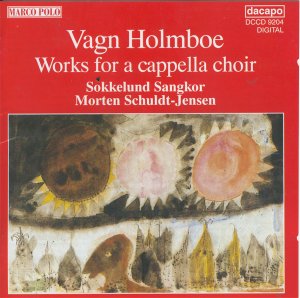|
|
Search MusicWeb Here |
|
 |
||
|
Founder:
Len Mullenger (1942-2025) Editor
in Chief:John Quinn
|
|
|
Search MusicWeb Here |
|
 |
||
|
Founder:
Len Mullenger (1942-2025) Editor
in Chief:John Quinn
|
 |
Vagn HOLMBOE (1909-2000) |
|
|
|
Holmboe's choral writing is full of light and suave sweetness. It is strongly coloured by folksong. His style touches various, possibly familiar, compass points: Holst, Howells (though luxuriant ecstasy is not Holmboe's aim), Geoffrey Bush and Vaughan Williams. Not for Holmboe the dramatics or extremes. He tends to write in unison blocks rather than multiple divisi. If you scratch the surface you can trace the lineage of works such as the Sange and the Psalms back to the Deutsches Volkslieder of Brahms. Less obviously is this the case with the two Border Ballads. The air-borne silver quality of This Ae Night contrasts intriguingly with Britten's setting in the Serenade. Both ballads are given pointed, humorous and virtuoso treatment by the Sokkelund choir. These two works would make a firmly favourable impression at any choral competition and I recommend them strongly to choral conductors. The Lagerkvist Songs reminded me of two British works: the luminosity of Tippett's Dance Clarion Air and the devotional archaicism of Bax's Mater Ora Filium. The celebration of Laudabo (a movement from his major a capella sequence, Liber Canticorum) reminds me of the joyous release of the closing pages of Rosenberg's Fourth Symphony - ecstatic ululating alleluias coursing freely over the top of the orchestra and the main choir. Frise is a five-movement arrangement in vocalisation of the Chamber Symphony Op. 103A. There is no text, only the hum, jabber and wail of syllables. This is a touchingly emotional work. Sample the Chiaro (tr. 22) with its unhurried cantilena and quietly pecking squeaks. Orff's Trionfi must surely have coloured the precisely controlled rattle of the voices in the Tempo Giusto and the Allegro con forza. |
|
Return to Index |